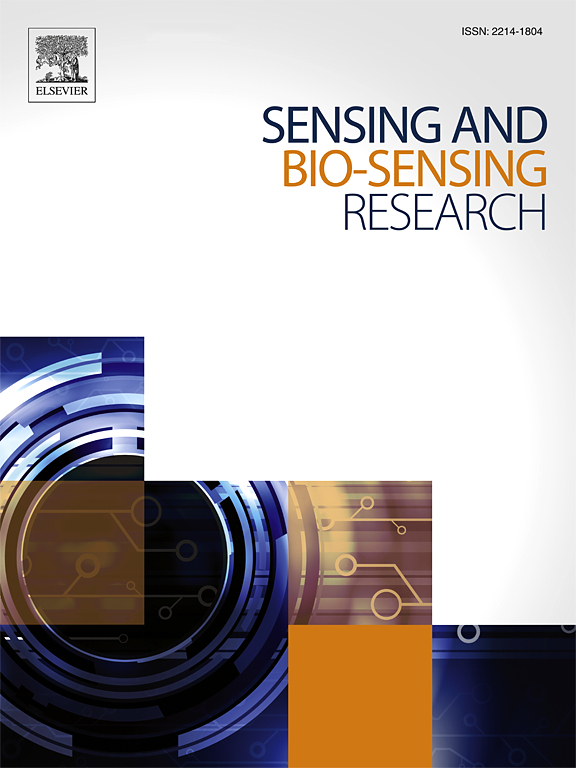Development of an electrochemical biosensor based on MOF@AuNPs nanocomposite for early-stage evaluation of ovarian cancer via CA125 oncomarker in human serum samples
IF 4.9
Q1 CHEMISTRY, ANALYTICAL
引用次数: 0
Abstract
Among gynecologic cancers, ovarian cancer (OC) is one of the main causes of mortality. Therefore, early detection is essential for successful treatment. We were motivated to develop a label-free electrochemical biosensor for the prompt evaluation of OC through cancer antigen 125 (CA125) due to the insufficiency of the sensitivity of the available diagnostic techniques. To improve conductivity and sensitivity, this biosensor uses gallate-based metal organic framework (MIL-156 MOF) nanocomposite decorated with gold nanoparticles (AuNPs). Large-surface-area MIL-156 MOF was electrodeposited onto a glassy carbon electrode (GCE) and then decorated with AuNPs. The chronoamperometry (CHA) technique was used to carry out both electrodeposition steps. The characteristics of nanomaterials were assessed using EDX, SEM, and XRD methods. Here, an electrochemical biosensor based on MOF@AuNPs is developed for the evaluation of ovarian cancer using a biotinylated monoclonal CA125 antibody. The differential pulse voltammetry (DPV) technique was applied to perform the electrochemical measurements. The designed biosensor showed a low limit of detection (LOD = 7.185 nU/mL), a dynamic linear range (10–70 nU/mL), and desirable repeatability and reproducibility for CA125 detection. Clinical serum sample analysis demonstrated its ability to improve patient outcomes and confirmed its practical application. Biomedical research and clinical diagnostics could benefit from this robust and selective biosensor platform for screening approaches.
基于MOF@AuNPs纳米复合材料的电化学生物传感器的研制,通过人血清样品中的CA125肿瘤标志物进行卵巢癌早期评估
在妇科癌症中,卵巢癌是导致死亡的主要原因之一。因此,早期发现对成功治疗至关重要。由于现有诊断技术的灵敏度不足,我们开发了一种无标记的电化学生物传感器,用于通过癌症抗原125 (CA125)快速评估卵巢癌。为了提高导电性和灵敏度,该生物传感器使用了金纳米粒子(AuNPs)装饰的没食子酸盐基金属有机框架(MIL-156 MOF)纳米复合材料。将大表面积MIL-156 MOF电沉积在玻璃碳电极(GCE)上,然后用AuNPs修饰。采用计时电流测定法(CHA)技术进行两个电沉积步骤。采用EDX、SEM和XRD等方法对纳米材料进行了表征。本文开发了一种基于MOF@AuNPs的电化学生物传感器,用于使用生物素化单克隆CA125抗体评估卵巢癌。采用差分脉冲伏安法(DPV)进行电化学测量。所设计的生物传感器具有低检出限(LOD = 7.185 nU/mL)、动态线性范围(10 ~ 70 nU/mL)和良好的重复性和再现性。临床血清样本分析证明了其改善患者预后的能力,并证实了其实际应用。生物医学研究和临床诊断可以受益于这种强大的和选择性的筛选方法的生物传感器平台。
本文章由计算机程序翻译,如有差异,请以英文原文为准。
求助全文
约1分钟内获得全文
求助全文
来源期刊

Sensing and Bio-Sensing Research
Engineering-Electrical and Electronic Engineering
CiteScore
10.70
自引率
3.80%
发文量
68
审稿时长
87 days
期刊介绍:
Sensing and Bio-Sensing Research is an open access journal dedicated to the research, design, development, and application of bio-sensing and sensing technologies. The editors will accept research papers, reviews, field trials, and validation studies that are of significant relevance. These submissions should describe new concepts, enhance understanding of the field, or offer insights into the practical application, manufacturing, and commercialization of bio-sensing and sensing technologies.
The journal covers a wide range of topics, including sensing principles and mechanisms, new materials development for transducers and recognition components, fabrication technology, and various types of sensors such as optical, electrochemical, mass-sensitive, gas, biosensors, and more. It also includes environmental, process control, and biomedical applications, signal processing, chemometrics, optoelectronic, mechanical, thermal, and magnetic sensors, as well as interface electronics. Additionally, it covers sensor systems and applications, µTAS (Micro Total Analysis Systems), development of solid-state devices for transducing physical signals, and analytical devices incorporating biological materials.
 求助内容:
求助内容: 应助结果提醒方式:
应助结果提醒方式:


